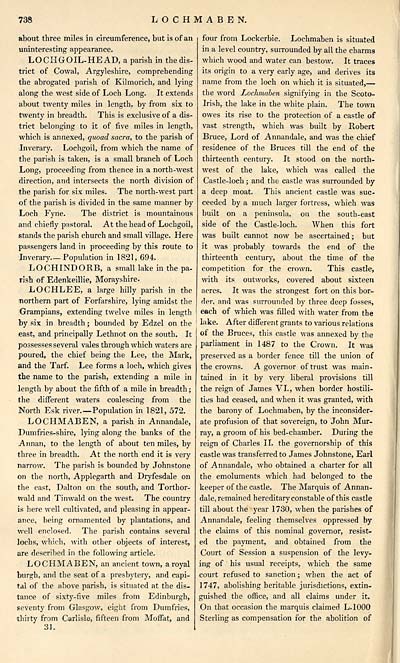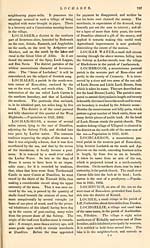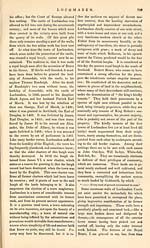Gazetteer of Scotland > Volume 2
(254) Page 738
Download files
Complete book:
Individual page:
Thumbnail gallery: Grid view | List view

738
LOCHMABEN.
about three miles in circumference, but is of an
uninteresting appearance.
LOCHGOIL-HEAD, a parish in the dis-
trict of Covval, Argyleshire, comprehending
the abrogated parish of Kilmorich, and lying
along the west side of Loch Long. It extends
about twenty miles in length., by from six to
twenty in breadth. This is exclusive of a dis-
trict belonging to it of five miles in length,
which is annexed, quoad sacra, to the parish of
Inverary. Loehgoil, from which the name of
the parish is taken, is a small braneh of Loch
Long, proceeding from thence in a north-west
direction, and intersects the north division of
the parish for six miles. The north-west part
of the parish is divided in the same manner by
Loch Fyne. The district is mountainous
and chiefly pastoral. At the head of Loehgoil,
stands the parish church and small village. Here
passengers land in proceeding by this route to
Inverary Population in 1821, 694.
LOCHINDORB, a small lake in the pa-
rish of Edenkeillie, Morayshire.
LOCHLEE, a large hilly parish in the
northern part of Forfarshire, lying amidst the
Grampians, extending twelve miles in length
by six in breadth; bounded by Edzel on the
east, and principally Lethnot on the south. It
possesses several vales through which waters are
poured, the chief being the Lee, the Mark,
and the Tarf. Lee forms a loch, which gives
the name to the parish, extending a mile in
length by about the fifth of a mile in breadth ;
the different waters coalescing from the
North Esk river— Population in 1821, 572.
LOCHMABEN, a parish in Annandale,
Dumfries-shire, lying along the banks of the
Annan, to the length of about ten miles, by
three in breadth. At the north end it is very
narrow. The parish is bounded by Johnstone
on the north, Applegarth and Dryfesdale on
the east, Dalton on the south, and Torthor-
wald and Tinwald on the west. The country
is here well cultivated, and pleasing in appear-
ance, being ornamented by plantations, and
well enclosed. The parish contains several
lochs, which, with other objects of interest,
are described in the following article.
LOCHMABEN, an ancient town, a royal
burgh, and the seat of a presbytery, and capi-
tal of the above parish, is situated at the dis-
tance of sixty-five miles from Edinburgh,
seventy from Glasgow, eight from Dumfries,
thirty from Carlisle, fifteen from Moffat, and
3].
four from Lockerbie. Lochmaben is situated
in a level country, surrounded by all the charms
which wood and water can bestow. It traces
its origin to a very early age, and derives its
name from the loch on which it is situated, —
the word Lochmaben signifying in the Scoto-
Irish, the lake in the white plain. The town
owes its rise to the protection of a castle of
vast strength, which was built by Robert
Bruce, Lord of Annandale, and was the chief
residence of the Bruces till the end of the
thirteenth century. It stood on the north-
west of the lake, which was called the
Castle-loch ; and the castle was surrounded by
a deep moat. This ancient castle was suc-
ceeded by a much larger fortress, which was
built on a peninsula, on the south-east
side of the Castle-loch. When this fort
was built cannot now be ascertained; but
it was probably towards the end of the
thirteenth century, about the time of the
competition for the crown. This castle,
with its outworks, covered about sixteen
acres. It was the strongest fort on this bor-
der, and was surrounded by three deep fosses,
each of which was filled with water from the
lake. After different grants to various relations
of the Bruces, this castle was annexed by the
parliament in 1487 to the Crown. It was
preserved as a border fence till the union of
the crowns. A governor of trust was main-
tained in it by very liberal provisions till
the reign of James VI., when border hostili-
ties had ceased, and when it was granted, with
the barony of Lochmaben, by the inconsider-
ate profusion of that sovereign, to John Mur-
ray, a groom of his bed-chamber. During the
reign of Charles II. the governorship of this
castle was transferred to James Johnstone, Earl
of Annandale, who obtained a charter for all
the emoluments which had belonged to the
keeper of the castle. The Marquis of Annan-
dale, remained hereditary constable of this castle
till about the year 1730, when the parishes of
Annandale, feeling themselves oppressed by
the claims of this nominal governor, resist-
ed the payment, and obtained from the
Court of Session a suspension of the levy-
ing of his usual receipts, which the same
court refused to sanction ; when the act of
1747, abolishing heritable jurisdictions, extin-
guished the office, and all claims under it.
On that occasion the marquis claimed L.1000
Sterling as compensation for the abolition of
LOCHMABEN.
about three miles in circumference, but is of an
uninteresting appearance.
LOCHGOIL-HEAD, a parish in the dis-
trict of Covval, Argyleshire, comprehending
the abrogated parish of Kilmorich, and lying
along the west side of Loch Long. It extends
about twenty miles in length., by from six to
twenty in breadth. This is exclusive of a dis-
trict belonging to it of five miles in length,
which is annexed, quoad sacra, to the parish of
Inverary. Loehgoil, from which the name of
the parish is taken, is a small braneh of Loch
Long, proceeding from thence in a north-west
direction, and intersects the north division of
the parish for six miles. The north-west part
of the parish is divided in the same manner by
Loch Fyne. The district is mountainous
and chiefly pastoral. At the head of Loehgoil,
stands the parish church and small village. Here
passengers land in proceeding by this route to
Inverary Population in 1821, 694.
LOCHINDORB, a small lake in the pa-
rish of Edenkeillie, Morayshire.
LOCHLEE, a large hilly parish in the
northern part of Forfarshire, lying amidst the
Grampians, extending twelve miles in length
by six in breadth; bounded by Edzel on the
east, and principally Lethnot on the south. It
possesses several vales through which waters are
poured, the chief being the Lee, the Mark,
and the Tarf. Lee forms a loch, which gives
the name to the parish, extending a mile in
length by about the fifth of a mile in breadth ;
the different waters coalescing from the
North Esk river— Population in 1821, 572.
LOCHMABEN, a parish in Annandale,
Dumfries-shire, lying along the banks of the
Annan, to the length of about ten miles, by
three in breadth. At the north end it is very
narrow. The parish is bounded by Johnstone
on the north, Applegarth and Dryfesdale on
the east, Dalton on the south, and Torthor-
wald and Tinwald on the west. The country
is here well cultivated, and pleasing in appear-
ance, being ornamented by plantations, and
well enclosed. The parish contains several
lochs, which, with other objects of interest,
are described in the following article.
LOCHMABEN, an ancient town, a royal
burgh, and the seat of a presbytery, and capi-
tal of the above parish, is situated at the dis-
tance of sixty-five miles from Edinburgh,
seventy from Glasgow, eight from Dumfries,
thirty from Carlisle, fifteen from Moffat, and
3].
four from Lockerbie. Lochmaben is situated
in a level country, surrounded by all the charms
which wood and water can bestow. It traces
its origin to a very early age, and derives its
name from the loch on which it is situated, —
the word Lochmaben signifying in the Scoto-
Irish, the lake in the white plain. The town
owes its rise to the protection of a castle of
vast strength, which was built by Robert
Bruce, Lord of Annandale, and was the chief
residence of the Bruces till the end of the
thirteenth century. It stood on the north-
west of the lake, which was called the
Castle-loch ; and the castle was surrounded by
a deep moat. This ancient castle was suc-
ceeded by a much larger fortress, which was
built on a peninsula, on the south-east
side of the Castle-loch. When this fort
was built cannot now be ascertained; but
it was probably towards the end of the
thirteenth century, about the time of the
competition for the crown. This castle,
with its outworks, covered about sixteen
acres. It was the strongest fort on this bor-
der, and was surrounded by three deep fosses,
each of which was filled with water from the
lake. After different grants to various relations
of the Bruces, this castle was annexed by the
parliament in 1487 to the Crown. It was
preserved as a border fence till the union of
the crowns. A governor of trust was main-
tained in it by very liberal provisions till
the reign of James VI., when border hostili-
ties had ceased, and when it was granted, with
the barony of Lochmaben, by the inconsider-
ate profusion of that sovereign, to John Mur-
ray, a groom of his bed-chamber. During the
reign of Charles II. the governorship of this
castle was transferred to James Johnstone, Earl
of Annandale, who obtained a charter for all
the emoluments which had belonged to the
keeper of the castle. The Marquis of Annan-
dale, remained hereditary constable of this castle
till about the year 1730, when the parishes of
Annandale, feeling themselves oppressed by
the claims of this nominal governor, resist-
ed the payment, and obtained from the
Court of Session a suspension of the levy-
ing of his usual receipts, which the same
court refused to sanction ; when the act of
1747, abolishing heritable jurisdictions, extin-
guished the office, and all claims under it.
On that occasion the marquis claimed L.1000
Sterling as compensation for the abolition of
Set display mode to: Large image | Transcription
Images and transcriptions on this page, including medium image downloads, may be used under the Creative Commons Attribution 4.0 International Licence unless otherwise stated. ![]()
| Gazetteers of Scotland, 1803-1901 > Gazetteer of Scotland > Volume 2 > (254) Page 738 |
|---|
| Permanent URL | https://digital.nls.uk/97433870 |
|---|
| Description | Volume II: Glenbanchor to Zetland. |
|---|---|
| Attribution and copyright: |
|
| Description | By Robert Chambers and William Chambers. Glasgow: Blackie & Son, 1838. 2 volumes. |
|---|---|
| Shelfmark | NF.1461.g.7 |
| Additional NLS resources: | |

